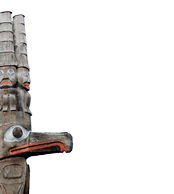 |
|||||||||
 |
|||||||||
 |
|||||||||

Inside Wawadiťła |
||
| Click and drag in the image to view the inside of Wawadiťła | ||
Kwakwaka’wakw Dance Screen, 1977Carver: Richard Hunt Log Drum, 2003Carver: David Knox and Mervyn Child |
||
 Mike Scott Photograph, RBCM Img0186a Mike Scott Photograph, RBCM Img0186a |
A human-like figure is flanked by shield-like copper plaques (Coppers), a form of wealth on the Northwest Coast. Whale, the body of which forms the drum. |
|
Houseposts, Rear of House |
||
 Mike Scott Photograph, RBCM Img0191 Mike Scott Photograph, RBCM Img0191 |
Huxwhukw, a companion of the cannibal Baxwbakwalanuxwsiwe', the supernatural spirit associated with the prestigious Hamatsa winter dance ceremony. It is the main crest of the Gixsam lineage of the Kwagu’ł. The birds’ beaks are hinged and can be made to open and shut. Grizzly Bear, a crest of the Wa'walibui lineage. |
|
Houseposts, Front of House |
||
 Mike Scott Photograph, Mike Scott Photograph, RBCM Img0194 |
Dzunukwa, a mythical wild woman who lives in the forest and is feared because she steals children. She is a sleepy, slow-moving giantess whose round mouth and protruding lips indicate her characteristic cry: ‘Hu, Hu, Hu’. This is a crest of the Kwikwasutinuxw people of Gilford Island. Grizzly Bear, a crest of the Wa'walibui lineage. |
|
Walls |
||
 Mike Scott Photograph, RBCM Img0192 Mike Scott Photograph, RBCM Img0192 Mike Scott Photograph, RBCM Img0192a Mike Scott Photograph, RBCM Img0192a Mike Scott Photograph, RBCM Img0193 Mike Scott Photograph, RBCM Img0193 |
Sisiyutł, a supernatural
double-headed serpent. This powerful being, the blood of which can
turn people to stone, is a ‘Namgis crest. The Sisiyutł image on the entrance wall was acquired in 1913 by Charles F. Newcombe either at the ławiťsis village of Kalugwis on Tournour Island or at the ‘Namgis community of ‘Yalis (Alert Bay). In 1941, it was attached to the façade of a building in Thunderbird Park where canoes were displayed. The Sisiyutł carvings on the side walls were painted for the house in 1960 by Mungo Martin and Henry Hunt. |
|
| Back to Wawadiťła |
